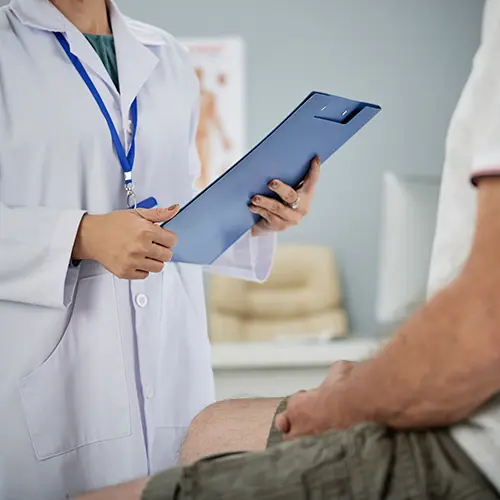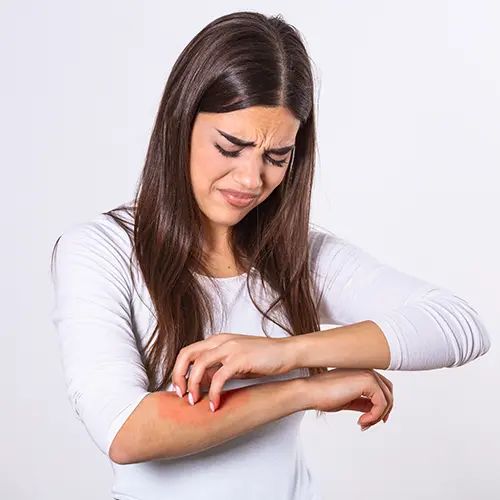Table of Contents
Skin rashes, an often underestimated health concern, can range from mild irritations to indicators of serious medical conditions.
Our comprehensive guide aims to demystify the complex world of skin rashes, offering valuable insights into their various types, causes, and treatments.
Whether you're dealing with a fleeting allergic reaction or a chronic skin disorder, understanding the nuances of skin rashes is crucial for effective management and relief.
In this guide, we delve into the signs and symptoms of common rashes, explore potential triggers, and provide expert advice on both home remedies and medical interventions.
Our goal is to empower you with the knowledge needed to identify and treat skin rashes, ensuring your skin health is never left to chance. Join us on this informative journey towards healthier skin.
What Causes Skin Rashes?
Skin rashes can be caused by a variety of factors, each leading to different types of rashes with distinct characteristics. Here are some common causes of skin rashes:
- Allergic Reactions: Allergic contact dermatitis occurs when the skin comes into contact with a substance that the immune system identifies as foreign. This can include certain metals (like nickel), fragrances, cosmetics, and plants like poison ivy.
- Infections: Bacterial, viral, or fungal infections can cause rashes. Examples include ringworm (fungal), impetigo (bacterial), and shingles or chickenpox (viral).
- Autoimmune Diseases: Conditions like psoriasis and lupus, where the body's immune system attacks its own tissues, can lead to rashes.
- Heat and Sweat: Heat rash or prickly heat occurs when sweat ducts become blocked and inflamed. This is common in hot, humid conditions.
- Medications: Certain medications can cause rashes as a side effect or as an allergic reaction. This is known as drug eruptions.
- Irritants: Direct contact with an irritant like a chemical, detergent, or soap can cause irritant contact dermatitis, leading to a rash.
- Food Allergies: In some cases, eating certain foods can cause an allergic reaction that includes a skin rash.
- Insect Bites and Stings: Bites from insects like mosquitoes or bed bugs, or stings from bees, can cause localized rashes.
- Underlying Medical Conditions: Some chronic diseases, like kidney or liver disease, can manifest with a rash.
- Stress: Emotional stress doesn't directly cause rashes, but it can aggravate existing skin conditions (like eczema, psoriasis, and hives).
- Environmental Factors: Exposure to sunlight, wind, or extreme temperatures can also cause or exacerbate skin rashes.
- Hormonal Changes: Hormonal fluctuations, such as those during pregnancy or menopause, can trigger rashes in some individuals.
It's important to identify the specific cause of a skin rash for appropriate treatment and management. In cases of persistent, worsening, or severe rashes, consulting a healthcare professional is recommended for accurate diagnosis and treatment.
How Can I Identify What Type of Rash I Have?
Identifying the type of skin rash you have can be challenging due to the wide range of possible causes and similar appearances of different rashes. However, certain characteristics can help you make a preliminary assessment, though it's always best to consult a healthcare professional for an accurate diagnosis. Here's a guide to help you identify common types of skin rashes:
- Appearance and Texture:
- Raised or Flat: Observe whether the rash is raised above the skin surface or flat.
- Color: Notice the color (red, purple, white, etc.) and whether it's uniform or has multiple colors.
- Shape and Pattern: Look for patterns like rings (common in ringworm), clusters (as seen in herpes simplex), or random distribution.
- Location:
- Certain rashes appear in specific areas, like eczema often occurring in the inner elbows or knees, and psoriasis commonly found on the scalp, elbows, and knees.
- Symptoms Accompanying the Rash:
- Itching or Burning: Rashes like eczema, hives, and allergic reactions often itch.
- Pain: Painful rashes may indicate an infection or shingles.
- Blisters or Ulcers: Some rashes form blisters or ulcers, like herpes simplex or impetigo.
- Duration and Pattern:
- Some rashes appear suddenly and resolve quickly (like allergic reactions), while others are chronic or recurrent (like psoriasis).
- Triggering Factors:
- Allergic reactions might occur after exposure to a specific substance.
- Heat rashes intensify in hot, humid weather.
- Associated Symptoms:
- Fever, joint pain, or a sore throat can accompany certain rashes, indicating a systemic condition.
- Personal and Family Medical History:
- History of allergies, asthma, or similar rashes in family members can be relevant.
- Recent Activities or Environmental Exposures:
- Consider recent outdoor activities, new products used, or changes in medications.
- Photographs for Comparison:
- Comparing your rash to photographs of common rashes online or in medical texts can be helpful, but remember that images can't capture all the nuances of a real-life rash.
- Response to Treatment:
- How a rash responds to treatment (like over-the-counter hydrocortisone cream) can provide clues.
Remember, while these guidelines can help in identifying your rash, they are not substitutes for a professional medical diagnosis. If your rash is persistent, worsening, or accompanied by other symptoms like fever or pain, it's important to seek medical advice.
When Should I See a Doctor for a Skin Rash?
Knowing when to see a doctor for a skin rash is important, as some rashes can indicate a more serious underlying condition or require specific treatment. Here are scenarios when it's advisable to seek medical attention:
- Persistent or Worsening Rash: If a rash doesn’t improve with home care or over-the-counter treatments within a few days, or if it’s getting worse, see a doctor.
- Severe Symptoms: Seek immediate medical attention if the rash is accompanied by severe pain or discomfort.
- Spreading Rapidly: A rash that spreads quickly over the body can be a sign of an allergic reaction or infection.
- Fever or Feeling Unwell: If the rash is accompanied by fever, joint pains, muscle aches, or a general feeling of illness, it could be a sign of a more serious condition.
- Infection Signs: Symptoms like increased warmth, red streaks, pus, or oozing from the rash suggest an infection.
- Rash after Medication: If a new rash appears soon after starting a medication, especially if it's widespread or includes blisters, seek medical advice immediately.
- Difficulty Breathing or Swelling: If you experience difficulty breathing, swelling of the face or lips, or tightness in the throat along with a rash, it could be a severe allergic reaction requiring urgent care.
- Exposure to Infectious Disease: If you’ve been exposed to someone with a contagious skin disease, such as chickenpox, and develop a rash.
- Involvement of Sensitive Areas: Rashes on sensitive areas like the eyes, mouth, or genitals should be evaluated.
- Change in Skin Color: A rash that causes the skin to turn purple, especially in a "bruise-like" pattern, should be assessed.
- Impact on Daily Activities: If the rash is affecting your sleep, daily activities, or causing psychological distress.
- Existing Health Conditions: Individuals with pre-existing health conditions, weakened immune systems, or chronic skin conditions should consult a doctor for any new or unusual rashes.
Remember, while many skin rashes are benign and treatable with home remedies or over-the-counter medications, some require professional medical attention. When in doubt, it's always safer to consult a healthcare provider for proper diagnosis and treatment.
How Are Skin Rashes Treated?
The treatment of skin rashes varies depending on the cause, severity, and individual patient needs. Here's an overview of common approaches to treating skin rashes:
- Topical Treatments:
- Corticosteroid Creams and Ointments: Used to reduce inflammation and itching, particularly for rashes like eczema or psoriasis.
- Antifungal Creams: For rashes caused by fungal infections, such as athlete's foot or ringworm.
- Antibiotic Ointments: Applied to bacterial skin infections to prevent or treat infection.
- Calamine Lotion: Provides relief from itching in rashes like poison ivy or chickenpox.
- Moisturizers: To soothe dry skin and maintain skin barrier function, especially in conditions like eczema.
- Oral Medications:
- Antihistamines: Help to relieve itching and swelling, particularly in cases of allergic reactions or hives.
- Oral Corticosteroids: For severe inflammatory responses, these can be prescribed for a short duration.
- Oral Antibiotics or Antifungals: For more severe or widespread infections.
- Lifestyle and Home Remedies:
- Cool Compresses: To reduce itching and inflammation.
- Oatmeal Baths: Can soothe itching and irritation, particularly in cases of chickenpox or sunburn.
- Avoiding Irritants: Identifying and avoiding substances that trigger rashes, such as certain fabrics, detergents, or skincare products.
- Dress in Comfortable Clothing: Wear loose, breathable fabrics to avoid further irritation.
- Phototherapy:
- In cases like psoriasis, controlled exposure to specific types of light can be beneficial.
- Immunomodulators:
- For chronic conditions like eczema or psoriasis, drugs that modify the immune response can be effective.
- Biologic Drugs:
- Advanced therapies for certain chronic conditions, like severe psoriasis, that target specific parts of the immune system.
- Dietary Changes:
- If the rash is related to a food allergy, avoiding the triggering food is necessary.
- Stress Management:
- For stress-related conditions like eczema or psoriasis, stress-reduction techniques can be helpful.
- Specialized Treatments:
- Depending on the cause, other specific treatments may be recommended, like antiviral medications for shingles.
- Avoid Scratching:
- Keeping nails short and wearing gloves at night can help prevent scratching, which can worsen the rash and lead to infection.
It's important to identify the underlying cause of the rash for effective treatment. Over-the-counter options may suffice for minor rashes, but persistent, severe, or unusual rashes should be evaluated by a healthcare professional. They can provide a proper diagnosis and recommend the most appropriate treatment plan.
F.A.Q
What is a skin rash?
A skin rash is any noticeable change in the texture or color of your skin. It can be itchy, red, bumpy, or irritated and may occur in a specific area or spread across larger sections of the body.
What causes skin rashes?
Skin rashes can be caused by a variety of factors including allergies, infections, heat, immune system disorders, medications, and contact with irritants. Common triggers include certain plants, chemicals in soaps or lotions, and exposure to certain fabrics.
How can I identify what type of rash I have?
Identifying a rash typically involves looking at its appearance, location, and any accompanying symptoms. Common types include eczema, psoriasis, hives, and heat rash. Consult a healthcare provider for an accurate diagnosis.
Are skin rashes contagious?
It depends on the cause. Rashes caused by infections, such as fungal infections or shingles, can be contagious. However, rashes due to allergies or chronic conditions are not.
When should I see a doctor for a skin rash?
Seek medical attention if your rash is accompanied by fever, pain, appears suddenly and spreads rapidly, or if you have any signs of infection (such as increased warmth or swelling).
How are skin rashes treated?
Treatment varies based on the type and cause of the rash. It may include over-the-counter creams, antihistamines, avoiding irritants, keeping the affected area clean and dry, or prescription medications for more severe cases.
Can diet affect skin rashes?
Yes, certain foods can trigger allergic reactions leading to rashes. Keeping a food diary can help identify potential triggers. A balanced diet can also support overall skin health.
How can I prevent skin rashes?
Prevention strategies include avoiding known irritants, using gentle skin care products, wearing appropriate clothing for the weather, and maintaining good hygiene. Regular moisturizing can also help protect your skin.
Are there home remedies for skin rashes?
Yes, home remedies such as oatmeal baths, aloe vera, and cool compresses can provide relief. However, it's important to identify the cause of the rash to ensure appropriate treatment.
Can stress cause skin rashes?
Stress can exacerbate many skin conditions, including rashes. Managing stress through relaxation techniques, exercise, and adequate sleep can help reduce the incidence of stress-related skin issues.




















